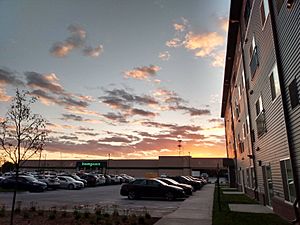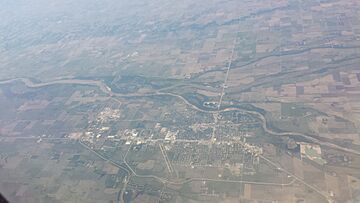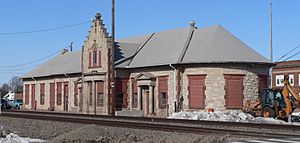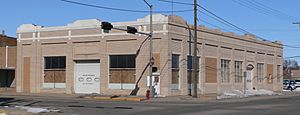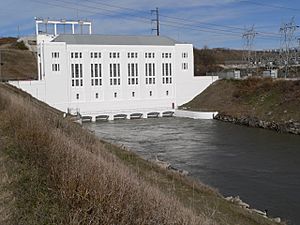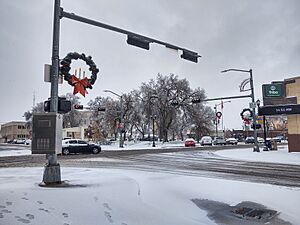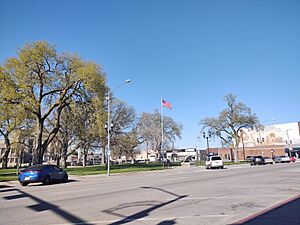Columbus, Nebraska facts for kids
Quick facts for kids
Columbus, Nebraska
|
|
|---|---|
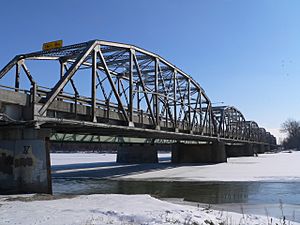
|
|
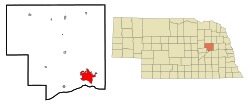 |
|
| Country | United States |
| State | Nebraska |
| County | Platte |
| Township | Columbus |
| Area | |
| • Total | 10.60 sq mi (27.46 km2) |
| • Land | 10.34 sq mi (26.78 km2) |
| • Water | 0.26 sq mi (0.68 km2) |
| Elevation | 1,447 ft (441 m) |
| Population
(2020)
|
|
| • Total | 24,028 |
| • Density | 2,323.79/sq mi (897.18/km2) |
| Time zone | UTC−6 (CST) |
| • Summer (DST) | UTC−5 (CDT) |
| ZIP codes |
68601-68602
|
| Area code | 402 |
| FIPS code | 31-10110 |
| GNIS feature ID | 837933 |
| U.S. Routes | |
| Intercity Bus | Express Arrow |
| Website | columbusne.us |
Columbus is a city in Nebraska, USA. It is the main city of Platte County, Nebraska. Columbus is located where the Loup and Platte rivers meet. It is about 85 miles (137 km) west of Omaha.
The city was first settled in May 1856. It was named after Columbus, Ohio. Its spot was chosen because it was along the planned route of the first transcontinental railroad.
Today, Columbus is a growing city. Its economy focuses on farming, making goods, and services like healthcare. The city has a mayor and a city council. It also has several radio stations and a newspaper called the Columbus Telegram. Central Community College has a campus nearby.
Contents
History of Columbus, Nebraska
Early Native American Tribes
In the 1700s, different Native American tribes lived around the Platte and Loup Rivers. These included the Pawnee, Otoe, Ponca, and Omaha tribes.
In 1720, the Pawnee and Otoe tribes, with help from the French, defeated a Spanish group led by Pedro de Villasur. This happened just south of where Columbus is now. Later, in 1739, French traders visited a Pawnee village near this spot.
In the 1800s, the "Great Platte River Road" was a major path for people moving west. This road followed the Platte River valley. The Loup River was a big challenge for travelers because of its soft banks. Most people traveled far up the Loup River before trying to cross it.
How Columbus Was Settled
Columbus was founded on May 28, 1856, by a group called the Columbus Town Company. They came from Columbus, Ohio, and named the new town after their old home. They picked this spot because it was on the planned route for the transcontinental railroad.
Another group had planned a town nearby called Pawnee. In November 1856, the two groups joined together.
When Columbus was first settled, the land still belonged to the Pawnee. But in 1857, the Pawnee signed a treaty. They gave up most of their land in Nebraska, except for a special area.
In 1858, Columbus officially became a town. It had only 16 citizens at that time. It soon became the main city of Platte County. A ferry was set up across the Loup River to help people cross.
Railroads Bring Growth
Columbus grew slowly until 1863. That year, construction began on the transcontinental railroad in Omaha. The Homestead Act also brought many new settlers to the area. This meant more people traveling through, which helped businesses. A floating bridge was built over the Loup River for summer use.
The railroad reached Columbus in June 1866. At that time, the city had about 75 people.
A man named George Francis Train had a big idea. He wanted to build a "highway of cities" along the Union Pacific railroad line. Columbus was meant to be one of these cities. In 1865, he bought many properties in Columbus. He even moved a hotel from a nearby town to Columbus. He believed Columbus should be the capital of the United States!
Columbus grew a lot in the 1870s. This was because of more farming in Platte County and more railroad traffic. The city became a trading hub for many nearby counties. When gold was found in the Black Hills Gold Rush in 1875, Columbus became a place for gold seekers to get supplies. They would take the train to Columbus and then travel overland.
In 1879, there was a lot of competition between railroad companies. The Burlington and Missouri Railroad wanted to build a line through Columbus. But Union Pacific owner Jay Gould did not like this idea. He threatened to harm Columbus if the new line was built. Even with his threats, the people voted for the new line. The Burlington and Missouri built a line to Columbus, but then chose a different route across Nebraska.
Gould tried to make good on his threat. He wanted a Union Pacific branch line to bypass Columbus. But a flood destroyed a bridge on that line in 1881. So, railroad officials agreed to reroute the line through Columbus. The city had to pay $25,000 for this.
The Age of Automobiles
In 1911, the Meridian Highway project started. This was a plan for a north-south road across the country. It crossed the Platte and Loup rivers at Columbus. In 1928, it became U.S. Highway 81.
In 1913, the Lincoln Highway was created. This was an east-west road across the country. It also crossed the Loup River at Columbus. In 1926, it became U.S. Highway 30.
Having these two major highways go through Columbus helped the city's businesses. Hotels grew, and new garages opened. The city paved and lit up downtown streets to attract drivers. By 1925, most of the main streets were paved.
The Great Depression in the 1930s was a very hard time for farmers in Platte County. Prices for crops and animals fell. Many farmers lost their land.
Columbus leaders worked hard to get money from the government for building projects. In 1931, the Meridian Viaduct was finished. This bridge carried the highways over the railroad tracks. New bridges were also built over the Platte and Loup rivers.
Hydroelectric Power
The biggest project during the Depression was building the Loup Project. This was a 35-mile (56 km) canal. It ran from the Loup River to the Platte River. The canal's water powers two hydroelectric power plants. One is near Monroe, and a larger one is in Columbus.
Construction started in 1934 and finished in 1938. At its busiest, the project employed over 1,300 people.
The Loup Project needed to sell its electricity. In 1939, a new group called Consumers Public Power District was formed in Columbus. Its goal was to buy power from the Loup Project and other projects. It then sold this power to homes and cities. By 1949, Nebraska became the only state where all electricity was provided by public companies.
From World War II to 2000
During World War II, Columbus tried to get a war factory built. The government bought land for an aluminum plant. But the war ended before it was built. The land was then sold and became an industrial area. In 1946, Behlen Manufacturing built a factory there.
In 1968, Columbus Public Schools stopped accepting students from outside the city. This led to the creation of Lakeview Community Schools for those students. Columbus also has several Catholic schools.
In 1997, a large amount of beef from a Hudson Foods plant in Columbus was recalled. This was the biggest recall in U.S. history at the time.
In 1999, the East-Central District Health Department was created. It serves Platte County, including Columbus, and three other counties.
Recent Years (2000-Present)
As of 2020, over 20% of Columbus residents are Hispanic or Latino. In 2009, a group called Centro Hispano Comunitario de Nebraska was founded in Columbus. It helps people with immigration, education, and business services.
In 2019, a man from Columbus died during floods. He was trying to help someone when a bridge he was on collapsed.
During the COVID-19 pandemic, the Columbus City Council passed a rule requiring masks. The mayor voted to approve it. Later, the rule was changed to only require masks if cases reached a certain level.
In 2020, voters approved a plan for a new community building. This building now holds the library, City Hall, an art gallery, a children's museum, and a coffee shop. It opened in July 2023.
In summer 2021, a fire at the Archer Daniels Midland facility in Columbus burned for several weeks.
Geography of Columbus
Columbus is about 85 miles (137 km) west of Omaha. It is on the north side of the Loup River, close to where it meets the Platte River. U.S. Highways 30 and 81 cross in the city. The main line of the Union Pacific railroad also runs through Columbus.
The city is 1,447 feet (441 meters) above sea level. It is built on the flat land of the Platte River valley. Rolling hills are found north of the city.
Columbus covers about 10.08 square miles (26.11 square kilometers). Most of this is land, with a small amount of water.
Climate in Columbus
Columbus has a climate with cold, dry winters and hot, humid summers. Most of the rain falls between April and October. The city gets about 28.67 inches (728 mm) of rain each year.
| Climate data for Columbus, Nebraska (1991–2020, extremes 1893–present) | |||||||||||||
|---|---|---|---|---|---|---|---|---|---|---|---|---|---|
| Month | Jan | Feb | Mar | Apr | May | Jun | Jul | Aug | Sep | Oct | Nov | Dec | Year |
| Record high °F (°C) | 70 (21) |
77 (25) |
92 (33) |
100 (38) |
103 (39) |
109 (43) |
115 (46) |
111 (44) |
105 (41) |
96 (36) |
85 (29) |
78 (26) |
115 (46) |
| Mean maximum °F (°C) | 55.2 (12.9) |
60.6 (15.9) |
74.4 (23.6) |
84.5 (29.2) |
91.8 (33.2) |
95.9 (35.5) |
97.8 (36.6) |
95.8 (35.4) |
92.2 (33.4) |
84.2 (29.0) |
70.1 (21.2) |
56.1 (13.4) |
99.2 (37.3) |
| Mean daily maximum °F (°C) | 32.3 (0.2) |
36.6 (2.6) |
49.6 (9.8) |
61.7 (16.5) |
72.8 (22.7) |
83.1 (28.4) |
86.9 (30.5) |
84.2 (29.0) |
77.4 (25.2) |
63.0 (17.2) |
47.7 (8.7) |
35.5 (1.9) |
60.9 (16.1) |
| Daily mean °F (°C) | 23.1 (−4.9) |
27.2 (−2.7) |
38.9 (3.8) |
50.4 (10.2) |
61.9 (16.6) |
72.4 (22.4) |
76.4 (24.7) |
73.9 (23.3) |
65.9 (18.8) |
52.0 (11.1) |
37.7 (3.2) |
26.6 (−3.0) |
50.5 (10.3) |
| Mean daily minimum °F (°C) | 13.8 (−10.1) |
17.7 (−7.9) |
28.2 (−2.1) |
39.0 (3.9) |
51.0 (10.6) |
61.7 (16.5) |
66.0 (18.9) |
63.6 (17.6) |
54.5 (12.5) |
41.1 (5.1) |
27.7 (−2.4) |
17.7 (−7.9) |
40.2 (4.6) |
| Mean minimum °F (°C) | −7.6 (−22.0) |
−2.9 (−19.4) |
7.8 (−13.4) |
23.1 (−4.9) |
35.6 (2.0) |
48.9 (9.4) |
55.1 (12.8) |
52.7 (11.5) |
38.7 (3.7) |
23.3 (−4.8) |
10.1 (−12.2) |
−2.5 (−19.2) |
−11.3 (−24.1) |
| Record low °F (°C) | −29 (−34) |
−29 (−34) |
−15 (−26) |
4 (−16) |
22 (−6) |
34 (1) |
41 (5) |
37 (3) |
24 (−4) |
6 (−14) |
−14 (−26) |
−25 (−32) |
−29 (−34) |
| Average precipitation inches (mm) | 0.65 (17) |
0.73 (19) |
1.39 (35) |
2.93 (74) |
4.57 (116) |
4.69 (119) |
3.46 (88) |
3.27 (83) |
2.48 (63) |
2.35 (60) |
1.22 (31) |
0.93 (24) |
28.67 (728) |
| Average snowfall inches (cm) | 6.6 (17) |
6.0 (15) |
3.8 (9.7) |
1.1 (2.8) |
0.0 (0.0) |
0.0 (0.0) |
0.0 (0.0) |
0.0 (0.0) |
0.0 (0.0) |
0.7 (1.8) |
1.8 (4.6) |
5.6 (14) |
25.6 (65) |
| Average precipitation days (≥ 0.01 in) | 5.0 | 5.1 | 6.9 | 8.5 | 11.1 | 10.2 | 8.6 | 8.8 | 7.0 | 7.3 | 4.7 | 5.6 | 88.8 |
| Average snowy days (≥ 0.1 in) | 3.4 | 3.3 | 1.5 | 0.5 | 0.0 | 0.0 | 0.0 | 0.0 | 0.0 | 0.3 | 1.3 | 3.4 | 13.7 |
| Source: NOAA | |||||||||||||
People Living in Columbus
| Historical population | |||
|---|---|---|---|
| Census | Pop. | %± | |
| 1870 | 526 | — | |
| 1880 | 2,131 | 305.1% | |
| 1890 | 3,134 | 47.1% | |
| 1900 | 3,522 | 12.4% | |
| 1910 | 5,014 | 42.4% | |
| 1920 | 5,410 | 7.9% | |
| 1930 | 6,898 | 27.5% | |
| 1940 | 7,632 | 10.6% | |
| 1950 | 8,884 | 16.4% | |
| 1960 | 12,476 | 40.4% | |
| 1970 | 15,471 | 24.0% | |
| 1980 | 17,328 | 12.0% | |
| 1990 | 19,480 | 12.4% | |
| 2000 | 20,971 | 7.7% | |
| 2010 | 22,111 | 5.4% | |
| 2020 | 24,028 | 8.7% | |
| U.S. Decennial Census 2018 Estimate |
|||
Columbus Population in 2020
The 2020 United States census counted 24,028 people in Columbus. There were 9,535 households and 5,732 families. The city had about 2,324 people per square mile.
- About 74.6% of the people were white.
- About 1.5% were black or African-American.
- About 1.1% were Native American.
- About 0.75% were Asian.
- About 12.3% were from other races.
- About 9.6% were from two or more races.
- About 23.0% of the population was Hispanic or Latino.
- About 28.4% of households had children under 18.
- About 45.9% were married couples.
- About 36.0% of households were single people living alone.
- The average household had 2.4 people.
- The average family had 3.2 people.
- About 25.1% of the population was under 18.
- About 16.4% were 65 or older.
- The average age in the city was 37.5 years.
Columbus Economy
Columbus's economy is based on farming and making goods. Many companies are drawn to the city because of its cheap and plentiful hydroelectric power.
Major companies that employ many people include:
- Becton Dickinson: A medical products company with two factories.
- Behlen Manufacturing: Makes steel buildings, grain bins, and farm equipment.
- Columbus Hydraulics Co.: Designs and makes hydraulic cylinders for farming, building, and other uses.
- CAMACO: Makes car seat frames.
- Cargill: Operates a ground-beef processing plant.
- Archer Daniels Midland: Runs a corn-milling facility.
- Vishay Dale Electronics: Makes electronic parts.
Other big employers include:
- Nebraska Public Power District: Its main office is in Columbus.
- Columbus Public Schools.
- Columbus Community Hospital.
Media in Columbus
Columbus has one newspaper, the Columbus Telegram. It is published five days a week.
There are also 6 radio stations in Columbus:
- KTLX (FM 91.3): Religious music.
- KKOT (FM 93.5): Plays classic hits.
- KZEN (FM 100.3): Plays country music.
- KLIR (FM 101.1): Plays adult contemporary music.
- KJSK (AM 900): A news talk station.
- KTTT (AM 1510): Plays polka and oldies country music.
Education in Columbus
The first public library in Columbus was built in 1913. The current Columbus Public Library opened in 1977.
Central Community College
A campus of Central Community College is located about 4 miles (6 km) northwest of Columbus. Their sports teams are called the Raiders.
Schools in Columbus
Columbus Public Schools runs Columbus High School, one middle school, and five elementary schools. Columbus High is the largest high school in the area, with 1,100 students. Its sports teams are the Discoverers.
Scotus Central Catholic High School is a Catholic school for grades 7 through 12. Their teams are the Shamrocks.
Lakeview Community Schools, which includes Lakeview High School, serves the rural area north of the city. Their teams are the Vikings.
Fun Things to Do in Columbus
- Andrew Jackson Higgins National Memorial: Located in Pawnee Park, this memorial has a life-sized replica of a Higgins boat. This type of boat was used a lot in World War II. The memorial also has sand from 58 important beaches around the world. There is also a Freedom Memorial with steel from the World Trade Center, which was destroyed on September 11, 2001.
- Glur's Tavern: Built in 1876, this is the oldest tavern west of the Missouri River that is still open. Famous people like "Buffalo Bill" Cody used to visit it. It is listed on the National Register of Historic Places.
- Agricultural Park: The Platte County Agricultural Society holds many events here. The Platte County Fair happens every year. You can also watch live horse racing from late July to mid-September. Races from other tracks are shown all year.
- U.S. 30 Speedway: This track hosts weekly car races from April to September.
- Columbus Marching Festival: High school marching bands from Nebraska and other states come here every September to perform.
- Columbus Days Parade: This parade is held every August in downtown Columbus.
Pawnee Plunge Water Park
Pawnee Plunge is an outdoor water park in Columbus. It opened in May 2006. It has four main waterslides, including a tube slide, a speed slide, and a unique splashbowl slide. The park also has a small "lazy river."
In its first week, over 13,000 people visited the park. The City of Columbus helps fund the park using a small sales tax.
Famous People from Columbus
Columbus is the birthplace of Andrew Jackson Higgins. He created the "Higgins boat," which was very important in World War II.
Other notable people who have lived in Columbus include:
- Chuck Hagel: A former US Secretary of Defense.
- Brad William Henke: An actor.
- Leon Spinks: A world heavyweight boxing champion.
- Emiel Christensen: An architect.
- Joe Blahak, Cory Schlesinger, and Chad Mustard: NFL football players.
- Lucas Cruikshank: Creator of the YouTube series FRED.
- Lon Milo DuQuette: An author and musician.
- Lotan Harold DeWolf: A Methodist minister and professor who was a mentor to Martin Luther King Jr..
- Marion Van Berg: A famous Thoroughbred racehorse trainer.
- Jack Van Berg: Marion's son, also a Hall of Fame horse trainer.
- Jim Pillen: The current governor of Nebraska.
- Ernest Hausmann: An American football linebacker.
See also
 In Spanish: Columbus (Nebraska) para niños
In Spanish: Columbus (Nebraska) para niños




